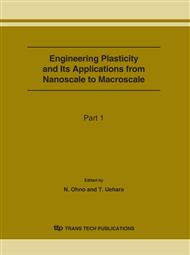p.1031
p.1037
p.1043
p.1049
p.1055
p.1061
p.1067
p.1073
p.1079
Implicit Formulation of Homogenization Method for Periodic Elastoplastic Solids
Abstract:
In this study, to determine incremental, perturbed displacement fields in periodic elastoplastic solids, an incremental homogenization problem is fully implicitly formulated, and an algorithm is developed to solve the homogenization problem. It is shown that the homogenization problem can be iteratively solved with quadratic convergences by successively updating strain increments in unit cells, and that the present formulation allows versatility in the initial setting of strain increments in contrast to previous studies. The homogenization algorithm developed is then examined by analyzing a holed plate, with an elastoplastic micro-structure, subjected to tensile loading. It is thus demonstrated that the convergence in iteratively solving the homogenization problem strongly depends on the initial setting of strain increments in unit cells, and that quick convergences can be attained if the initial setting of strain increments is appropriate.
Info:
Periodical:
Pages:
1055-1060
Citation:
Online since:
June 2007
Authors:
Price:
Сopyright:
© 2007 Trans Tech Publications Ltd. All Rights Reserved
Share:
Citation:


